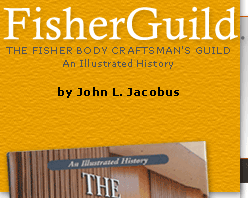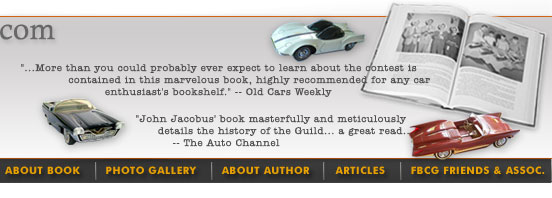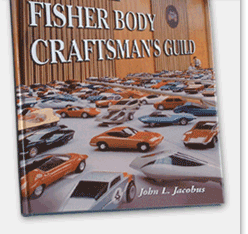|
T R A N S C R
I P T O F R
E V I E W
Fisher Body Craftsman's Guild
By Rob McLellan
The odds are that when you were a teenager
you were dreaming of owning a special car.
Not just an everyday mode of transportation,
but something different that projected your
personality. Buying popular magazines and
visiting auto dealerships and car shows,
you viewed the latest offerings and picked
up the sales brochures. Great as the new
cars were, the concepts or experimental
cars were better. Longer, lower and sleaker,
they were magic. They set your mind in motion
as to possibilities for the future.
Prior to the Chrysler Airflows and Cord
810/812, most makes differed little other
than grille shapes and chrome ornamentation.
Suddenly, in the mid-1930s, the influence
of aerodynamics was seized from the sleek
monoplanes and incorporated into the styling
of auto body work. The public was enthusiastic
and we were all style conscious. Boys were
sketching designs in their school notebooks
and at home they decorated their bedroom
walls with colorful drawings. Designs got
wilder in the 1950s with fins and lots of
chrome and sculpturing.
The Fisher Body Division of General Motors
began in 1930 to encourage teenagers to
compete for college scholarships by building
Napoleonic coach models. The coach was their
trademark and the contest concentrated on
following precise instructions that tested
the competitors' construction skills. In
1937 the Fisher Body Guild contest unlocked
the dreams of potential designers so they
could display what they believed future
cars should look like. In his book, The
Fisher Body Craftsman's Guild, John Jacobus
quotes from the placard in the Guild exhibit
case at the Smithsonian Institution, "From
1930 to 1968 millions of boys fascinated
by cars joined the Fisher Body Craftsman's
Guild. About 600,000 members enrolled each
year in the 1950s making the Guild second
in size only to the Boy Scouts of America
for young men."
JOHN L. JACOBUS
"John L. Jacobus recently retired from
the U. S. Department of Transportation in
Washington, DC. Previously he worked as
a Design Engineer for the Fisher Body Division,
General Motors Corporation in Warren, Michigan.
John studied Industrial Design at the Art
Center College of Design in California and
at Wayne State University in Detroit. As
a youth, he participated in the Craftsman's
Guild from 1961 to 1966. His hobby and passion
for the past 40 years has been automobiles,
automotive history and automotive design
history. During the past 20 years, John
has focused on auto stylists and designers
and the collecting of Fisher Body Craftsman's
Guild memorabilia. He was also instrumental
in a Craftsman's Guild exhibit and collection
at the Smithsonian Institution's National
Museum of American History. His writing
credits include Automobile Quarterly and
with co-author Skip Geear he was published
in the SAH Automotive History Review."
After John's article on the Guild appeared
in Automobile Quarterly, Vol. 25, No. 2,
1987, I contacted him and we have been constantly
in touch ever since. Like so many other
Guild contestants, I encouraged him to publish
a book on the Guild. That had long been
his goal. The dedication, perseverance and
exhaustive research that went into this
book has been phenomenal. And the book shows
his passion. John, congratulations on fulfilling
your dream. And thank you for presenting
to thousands of readers the opportunity
to enjoy this grand accomplishment. The
book will undoubtedly be purchased by all
former Guildsmen and those would-be designers
who wish they had participated. A call to
arms! Spread the word! The book is now available
through www.fisherguild.com.
THE BOOK
I find that the better I know the subject,
the more critical my review is. After all,
when the subject is new to me I am less
likely to spot errors and more likely to
find it interesting. In this case, I looked
forward to the book with great anticipation
because I was very familiar with the subject,
but with great trepidation knowing I could
readily detect errors. My expectations had
been built up for almost 20 years and the
book was now in my hands. I am relieved
to say, now that I have read it, that it
has exceeded my expectations. It is what
it should be and it does it well.
Neither a text book nor a dry history, it
is more like a collection of short stories.
After reading the introduction (Chapter
1), I jumped around reading the sections
that I knew would relate to my Guild days
of the late 1950s. The stories of the competitors
(Chapter IV) drew my interest because these
were my competitors. When I built my models
I did not know a single contestant. Maybe
that was good and was what GM wanted —
independent thought with no supervision.
Determining my own design, construction
materials, methods, etc., was an exciting
approach. Now for the first time all the
parts of the Guild puzzle are laid out before
me and other Guildsmen were telling their
stories.
Going to Chapter III on the competition
itself, I found topics like "Trim From
Common Household Items" and "Construction
Materials and Methods Used". Wow things
I never thought of!
By the time I finished the book I wondered,
"Why did the competition end?"
Apparently no one knows. If brought back
to life today, I would bet it would be more
popular than ever.
At www.FisherGuild.com
you will find a more comprehensive review
of the book's contents. In brief, if you
are interested in auto design, Guild history
or model making, you will enjoy reading
this book. Even if you did not compete in
the Guild, or have never heard about the
Guild, as an automotive enthusiast the odds
are you will find this book fascinating.
:: Contact the author through his
web site at johnjacobus@fisherguild.com
and tell him that you read about the book
at www.AutomotiveChronicles.com
for a 20% discount off the retail price.
For article on reunion of the Guildsmen,
which took place in November of 2004, go
to Fisher
Body Craftsman's Guild Reunion.
To learn more about the history of Fisher
Body Divisions, GMC and the famous Fisher
Body Craftsman's Guild (1930-1968) public
relations program see:
http://www.geocities.com/sponcom26/index.html
|




